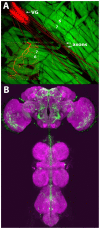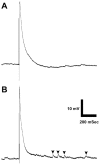Probing Synaptic Transmission and Behavior in Drosophila with Optogenetics: A Laboratory Exercise
- PMID: 30254546
- PMCID: PMC6153003
Probing Synaptic Transmission and Behavior in Drosophila with Optogenetics: A Laboratory Exercise
Abstract
Optogenetics is possibly the most revolutionary advance in neuroscience research techniques within the last decade. Here, we describe lab modules, presented at a workshop for undergraduate neuroscience educators, using optogenetic control of neurons in the fruit fly Drosophila melanogaster. Drosophila is a genetically accessible model system that combines behavioral and neurophysiological complexity, ease of use, and high research relevance. One lab module utilized two transgenic Drosophila strains, each activating specific circuits underlying startle behavior and backwards locomotion, respectively. The red-shifted channelrhodopsin, CsChrimson, was expressed in neurons sharing a common transcriptional profile, with the expression pattern further refined by the use of a Split GAL4 intersectional activation system. Another set of strains was used to investigate synaptic transmission at the larval neuromuscular junction. These expressed Channelrhodopsin 2 (ChR2) in glutamatergic neurons, including the motor neurons. The first strain expressed ChR2 in a wild type background, while the second contained the SNAP-25ts mutant allele, which confers heightened evoked potential amplitude and greatly increased spontaneous vesicle release frequency at the larval neuromuscular junction. These modules introduced educators and students to the use of optogenetic stimulation to control behavior and evoked release at a model synapse, and establish a basis for students to explore neurophysiology using this technique, through recapitulating classic experiments and conducting independent research.
Keywords: Drosophila; SNAP-25; behavior; electrophysiology; neuromuscular junction; optogenetics.
Figures



Similar articles
-
Light Activated Escape Circuits: A Behavior and Neurophysiology Lab Module using Drosophila Optogenetics.J Undergrad Neurosci Educ. 2015 Jul 7;13(3):A166-73. eCollection 2015 Summer. J Undergrad Neurosci Educ. 2015. PMID: 26240526 Free PMC article.
-
Optogenetics in the teaching laboratory: using channelrhodopsin-2 to study the neural basis of behavior and synaptic physiology in Drosophila.Adv Physiol Educ. 2011 Mar;35(1):82-91. doi: 10.1152/advan.00125.2010. Adv Physiol Educ. 2011. PMID: 21386006 Free PMC article.
-
Optogenetic analysis of neuromuscular transmission in the colon of ChAT-ChR2-YFP BAC transgenic mice.Am J Physiol Gastrointest Liver Physiol. 2019 Nov 1;317(5):G569-G579. doi: 10.1152/ajpgi.00089.2019. Epub 2019 Aug 14. Am J Physiol Gastrointest Liver Physiol. 2019. PMID: 31411893 Free PMC article.
-
Optogenetics in Drosophila.Adv Exp Med Biol. 2021;1293:309-320. doi: 10.1007/978-981-15-8763-4_19. Adv Exp Med Biol. 2021. PMID: 33398822 Review.
-
Roles of SNARE proteins and synaptotagmin I in synaptic transmission: studies at the Drosophila neuromuscular synapse.Neurosignals. 2003 Jan-Feb;12(1):13-30. doi: 10.1159/000068912. Neurosignals. 2003. PMID: 12624525 Review.
Cited by
-
An optogenetics device with smartphone video capture to introduce neurotechnology and systems neuroscience to high school students.PLoS One. 2022 May 6;17(5):e0267834. doi: 10.1371/journal.pone.0267834. eCollection 2022. PLoS One. 2022. PMID: 35522662 Free PMC article.
-
Development and Application of an Optogenetic Manipulation System to Suppress Actomyosin Activity in Ciona Epidermis.Int J Mol Sci. 2023 Mar 16;24(6):5707. doi: 10.3390/ijms24065707. Int J Mol Sci. 2023. PMID: 36982781 Free PMC article.
-
Classroom-Based Research Experiences to Support Underserved STEM Student Success: From Introductory Inquiry to Optogenetics in the Embryonic Chicken.J Undergrad Neurosci Educ. 2018 Dec 15;17(1):A97-A110. eCollection 2018 Fall. J Undergrad Neurosci Educ. 2018. PMID: 30618506 Free PMC article.
-
Building Your Own Neuroscience Equipment: A Precision Micromanipulator and an Epi-fluorescence Microscope for Calcium Imaging.J Undergrad Neurosci Educ. 2020 Dec 31;19(1):A134-A140. eCollection 2020 Fall. J Undergrad Neurosci Educ. 2020. PMID: 33880101 Free PMC article.
-
Pandemic Teaching: Using the Allen Cell Types Database for Final Semester Projects in an Undergraduate Neurophysiology Lab Course.J Undergrad Neurosci Educ. 2021 Dec 24;20(1):A100-A110. eCollection 2021 Fall. J Undergrad Neurosci Educ. 2021. PMID: 35540944 Free PMC article.
References
-
- Boyden ES, Zhang F, Bamberg E, Nagel G, Deisseroth K. Millisecond-timescale, genetically targeted optical control of neural activity. Nat Neurosci. 2005;8:1263–1268. - PubMed
LinkOut - more resources
Full Text Sources
Molecular Biology Databases
Miscellaneous
